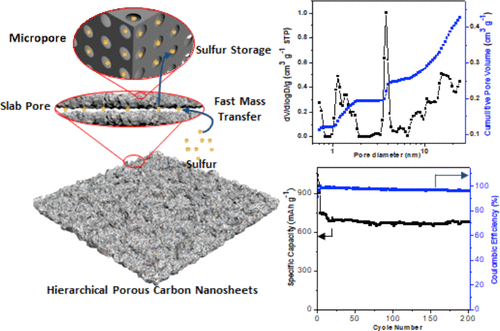Our official English website, www.x-mol.net, welcomes your
feedback! (Note: you will need to create a separate account there.)
Template-Free Preparation of Hierarchical Porous Carbon Nanosheets for Lithium–Sulfur Battery
Langmuir ( IF 3.7 ) Pub Date : 2020-11-25 , DOI: 10.1021/acs.langmuir.0c02167 Yang Du 1 , Rongkang Huang 2 , Xidong Lin 1 , Shaukat Khan 1 , Bingna Zheng 1 , Ruowen Fu 1
Langmuir ( IF 3.7 ) Pub Date : 2020-11-25 , DOI: 10.1021/acs.langmuir.0c02167 Yang Du 1 , Rongkang Huang 2 , Xidong Lin 1 , Shaukat Khan 1 , Bingna Zheng 1 , Ruowen Fu 1
Affiliation

|
Porous carbon nanosheets have the advantages of longitudinal continuity, transverse ultrathin, high specific surface area, and surface atomic activity, as well as the synergistic effect of micro and nanoproperties, so the research on their preparation, structure, and properties has attracted wide attention. A series of ultrathin hierarchical porous carbon nanosheets (HPCNs) is fabricated through carbonization of precursors obtained through the Friedel–Crafts reaction-assisted loading of polystyrene on graphene oxide. Hierarchical pore structures consist of three parts: (1) the micropores (1.3 nm), which were provided by porous polystyrene through the Friedel–Crafts reaction; (2) the mesopores (3.8 nm), which were provided by slab pores from the stack of carbon nanosheets; and (3) the pores (>5 nm) formed from the random stack of carbon nanosheets. Controlling the carbonization time and temperature adds to a prominent increase in specific surface area from 405.8 to 1420 m2 g–1. It was found that excessive carbonization would destroy the hierarchical pore structure. These porous carbon materials were used as cathode materials for lithium–sulfur battery and showed good performance. HPCN/sulfur cathode has good rate performance and cycle performance, and the capacity retention rate is 87% after the current density rises from 1 to 3 C and 91% after 200 cycles.
中文翻译:

无模板锂硫电池多孔碳纳米片的制备
多孔碳纳米片具有纵向连续性,横向超薄性,高比表面积和表面原子活性以及微观和纳米性质的协同效应等优点,因此对其制备,结构和性质的研究引起了广泛的关注。通过前驱体的碳化来制造一系列超薄的分级多孔碳纳米片(HPCN),这些前驱体是通过Friedel-Crafts反应辅助将聚苯乙烯负载在氧化石墨烯上而获得的。分层孔隙结构由三部分组成:(1)微孔(1.3 nm),由多孔聚苯乙烯通过Friedel-Crafts反应提供。(2)中孔(3.8 nm),由碳纳米片堆叠中的平板孔提供;和(3)毛孔(> 由碳纳米片的无规堆叠形成5nm)。控制碳化的时间和温度会使比表面积从405.8 m显着增加到1420 m2克–1。发现过度碳化会破坏分层的孔结构。这些多孔碳材料被用作锂硫电池的正极材料,并表现出良好的性能。HPCN /硫阴极具有良好的倍率性能和循环性能,电流密度从1 C升至3 C后,容量保持率为87%,经过200次循环后,容量保持率为91%。
更新日期:2020-12-08
中文翻译:

无模板锂硫电池多孔碳纳米片的制备
多孔碳纳米片具有纵向连续性,横向超薄性,高比表面积和表面原子活性以及微观和纳米性质的协同效应等优点,因此对其制备,结构和性质的研究引起了广泛的关注。通过前驱体的碳化来制造一系列超薄的分级多孔碳纳米片(HPCN),这些前驱体是通过Friedel-Crafts反应辅助将聚苯乙烯负载在氧化石墨烯上而获得的。分层孔隙结构由三部分组成:(1)微孔(1.3 nm),由多孔聚苯乙烯通过Friedel-Crafts反应提供。(2)中孔(3.8 nm),由碳纳米片堆叠中的平板孔提供;和(3)毛孔(> 由碳纳米片的无规堆叠形成5nm)。控制碳化的时间和温度会使比表面积从405.8 m显着增加到1420 m2克–1。发现过度碳化会破坏分层的孔结构。这些多孔碳材料被用作锂硫电池的正极材料,并表现出良好的性能。HPCN /硫阴极具有良好的倍率性能和循环性能,电流密度从1 C升至3 C后,容量保持率为87%,经过200次循环后,容量保持率为91%。











































 京公网安备 11010802027423号
京公网安备 11010802027423号